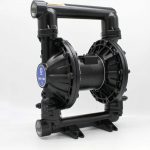Uma grande preocupação entre os usuários de bomba pneumática de diafragma é a sua capacidade de bombear fluidos viscosos. Isso porque existe uma grande dúvida quanto à capacidade de viscosidade máxima que essas bombas conseguem bombear sem danificar o equipamento e sem prejudicar a sua operação.
É muito importante lembrar que, com relação ao bombeamento de fluidos viscosos, a tubulação utilizada é um fator primordial. O sistema de tubulação deve considerar o tipo de fluido a ser bombeado e a presença de detritos, partículas, grau de viscosidade, temperatura, entre outros fatores.
For this reason, before choosing a pneumatic diaphragm pump, it is essential to specify characteristics of the fluid to guarantee the best equipment. With several options on the market, your pneumatic diaphragm pump must be chosen according to specific characteristics and its application within the industry.
Viscous Fluids and Flow
When dealing with pneumatic diaphragm pumps, it is essential to compare their dry lifting capacity with the loss in the suction line. In this sense, we need to analyze whether the lifting capacity exceeds the loss in the suction line according to the flow expected by the industry.
For this reason, first of all it is necessary to calculate the loss according to the flow expected by your operation. It is also essential to consider the diameter of the tube used to deliver the productivity expected by the equipment.
It is very common that, to compensate for the loss, it is necessary to increase the diameter of the suction line. In systems where the suction line exceeds capacity, pneumatic diaphragm pumps may not deliver the expected functionality and productivity.
Total operating head X pneumatic diaphragm pump
Fluid is transferred to the pneumatic diaphragm pump when the air pressure exceeds the dynamic head of the system. To ensure that your pump is able to deliver capacity and availability, in addition to an extended useful life, it is essential that the system operates within the equipment's average capacity range.
To achieve this value, it is necessary to determine the total static load and the line loss within your production. When this loss exceeds the maximum pump pressure, it is necessary to optimize the equipment with the largest diameter in the discharge line.
Choosing your pneumatic diaphragm pump according to the operating characteristics is the determining factor for this equipment to be productive and efficient. For this reason, before opting for a specific pneumatic diaphragm pump, consider all the factors that may impact its flow rate and productivity.
Because it is very versatile and efficient equipment, pneumatic diaphragm pumps are one of the best choices within the Industrial environment. In addition to ensuring productivity and safety, this pump also has specific features that make it one of the best solutions on the market, as we will see below:
- We can run dry;
- Allow efficient handling of solids;
- Bomb Deadhead security;
- They do not harm the final product, as they do not cause shear;
- They do not need electricity to function;
- Features a initial acquisition cost lower than other solutions on the market;
- They are self-priming;
- They are submersible;
- Features a sealless design;
- Allows variable invasion and pressure without the need for sophisticated controls;
- Chemical resistance (as long as the compatibility table is observed);
- Resistance to high temperatures;
- They are easy to clean;
- Present certification standards
- They are portable;
- And much more.
For this reason, this equipment can be used to pump different types of fluid in industries from different segments, being an intelligent and economical solution to guarantee more productivity within industries.
Know the PNEUMATIC DIAPHRAGM PUMPS WITH FLAP – HUSKY 2150LP- GRACO










